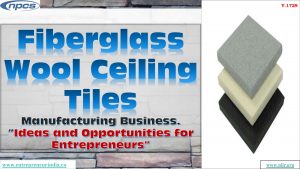Fiberglass Wool Ceiling Tiles Production Business. Great Ideas and Opportunities for Entrepreneurs

INTRODUCTION
A secondary ceiling, hung below the primary (structural) ceiling, is known as ceiling tiles. It’s also known as a drop ceiling, T-bar ceiling, false ceiling, suspended ceiling, grid ceiling, drop in ceiling, drop out ceiling, or ceiling tiles, and it’s a popular choice for both residential and commercial construction.
Fiberglass acoustic ceiling tiles are lightweight and simple to handle, with excellent sound absorption. Mineral Fiber Ceiling Tiles have excellent thermal and acoustic insulation. Fiberglass and Mineral Fiber Ceiling Tiles are available in a variety of price points, with the best sound absorption (NRC) to help you achieve the best acoustics for your project.
Fiberglass ceilings and Mineral Fiber Ceiling Tiles are available in a variety of fire-rated, naturally resistant to mould and mildew growth, compatible with standard suspension systems and perimeter trim, unique views such as form and blade, and texture, shape, and colour.
Uses and Applications:
Fiber Ceiling Tiles are acoustical and thermal ceiling tiles for suspended ceiling systems used in industrial, commercial, and institutional settings. This decorative mineral fibre ceiling tile will satisfy the designer’s requirements for acoustic control, aesthetic appeal, and thermal efficiency.
These tiles improve working performance, concentration, and reduce noise and tension caused by echo and white noises in offices. These ceiling panels eliminate echo and boom in theatres and lecture halls, making sound systems more audible, transparent, and crisp.
When used with Uni steel Black Grid, black ceiling tiles minimise light reluctance and provide a non-intruding presence in the interior decor, making them suitable for cinemas and home theatres.
- Suspended commercial ceilings
- Multiplexes
- Auditoriums
- Movie theatres
- Lecture Theatres
- Public libraries
- Offices that are open plan
- meeting rooms for conferences
- Studios for filming
- Bars and Pubs
- Home theatre systems
- Yoga and meditation centres
- Public areas
Related Project: Investment Opportunities in Fiberglass Wool Ceiling Tiles
Production Process
Fiber ceilings are a sound-absorbing green building material that can be recycled.
- The manufacturing of mineral wool decorative sound-absorbing panels is a lengthy process. Wet-laid wire netting, wet round wire netting, dry-laminating and moulding, and semi-drying methods are all available. Wet process is used by the majority of producers. It is formed by pulping, long wire netting, dewatering, slitting, drying, slitting, spraying, and finishing wet long wire netting. Wait for the entire wet process development process to be completed in two stages. The various raw materials are first mixed and processed into a substrate board, after which they are decorated.
- Decorative processing
Blind hole processing: Semi-finished products are rolled to create impermeable holes of various sizes and shapes to improve the sound absorption effect, and then edge processing, colouring, and drying are completed.
Processing of printing plates: Blind hole plates are processed into vertical and horizontal grooves using special milling machines, or they are milled, coloured, and dried in a circular fashion. semi-finished items are painted with pre-matched paint and printed on a template on a printing machine, and the designs may also be sprinkled with fine sand and dried.
Embossed plate processing: After the semi-finished product is coloured, different patterns are pressed out using embossed plates in a press, and then cut and tenoned. The relief plate is manufactured by a reputable company, and the manufacturing costs are substantial.
Related Videos: Plastics Projects
Market Outlook
In 2020, the global ceiling tile market is expected to be worth USD 5.93 billion. From 2021 to 2028, it is projected to rise at a compound annual growth rate (CAGR) of 8.8%. Development in the commercial construction industry is expected to drive the market, with new office towers, institutional buildings, healthcare facilities, and malls being built all over the world.
With growing demand for acoustic and thermal insulation, rising disposable income in developing countries, and changing customer preferences for home and office building aesthetics, the market is expected to expand.
The market dynamics are expected to benefit from the use of sustainable and creative building methods that include the use of eco-friendly materials for ceilings, floors, and walls. Mineral fibres, metals, gypsum, fibreglass, plastics, and wood are among the raw material manufacturers with a wide presence on the market.
Market Research: – Market Research Report
Backward and forward integration techniques are being used by manufacturers to gain leverage over the quality of raw materials used to make tiles, as well as to increase their customer base by managing distribution networks.
Several firms, including Armstrong Roof, Knauf, and ROCKWOOL INSULATION A/S, have invested in the development of ceiling tiles with high fire resistance properties, and the industry is expected to expand significantly. This is due to a rise in the demand for healthy residential, commercial, and industrial complex construction. Green building practises are expected to spread through developed economies in North America and Europe, as well as major developing regions in Asia Pacific, as people become more aware of the benefits of using environmentally sustainable building materials. In addition, key players’ increasing adoption of reuse and recycling of building materials is expected to drive market growth in the coming years.
Projects:- Project Reports & Profiles
Few Indian Major Players
- K-Flex India Pvt. Ltd.
- Kingspan Jindal Pvt. Ltd.
- Lloyd Insulations (I) Ltd.
- Owens Corning Inds. (India) Pvt. Ltd.
- Rock Wool (India) Pvt. Ltd.
- Saint-Gobain Gyproc India Ltd.